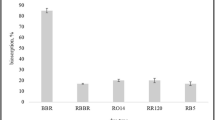Abstract
Galactomyces geotrichum was utilized as a potential biosorbent for the treatment of tannery effluent under controlled environmental conditions. Tannery effluent treatment was studied through parametric experiments to study the effect of effluent pH (3.0–10.0), initial COD (1100–4400 mg/L), and biosorbent dosage (0.3–3.0 g/L).The zeta potential of the biosorbent was determined and found to influence the optimal pH. Increase in effluent COD values resulted in decreased COD removal percentages which attributed to limited availability of surface active sites. The equation relating the COD removal efficiency and biosorbent dose was proposed. Two popular kinetic models, namely pseudo-second order and power function models, were employed to the experimental data. Pseudo-second order model proved to be a good fit with high values of regression coefficient (R 2 > 0.960). Potential application of a fungal biosorption process was explored and the optimal process parameters were identified.





Similar content being viewed by others
References
Al-Rashdi N, Rajamohan N, Ramachandran KP (2017) Synthesis and application of Sargassum ilicifolium based biomass for the selective removal of phenol. Biocatal Agric Biotechnol 9:236–239
APHA (2005) Standard methods for the examination of water and waste water, 21st edn. American Public Health Association, Washington, DC
Bhattacharya P, Majumdar S, Bandyopadhyay S, Ghosh S (2016) Recycling of tannery effluent from common effluent treatment plant using ceramic membrane based filtration process: a closed loop approach using pilot scale study. Environ Prog 35:60–69
Das N (2010) Recovery of precious metals through biosorption—a review. Hydrometallurgy 103:180–189
Dasgupta J, Mondal D, Chakraborty S, Sikder J, Curcio S, Arafat HA (2015) Nanofiltration based water reclamation from tannery effluent following coagulation pretreatment. Ecotox Environ Safe 121:22–30
Dogruel S, Genceli EA, Babuna FG, Orhon D (2006) An investigation on the optimal location of ozonation within biological treatment for a tannery wastewater. J Chem Technol Biotechnol 81:1877–1885
Durai G, Rajasimman M, Rajamohan N (2011) Aerobic digestion of tannery wastewater in a sequential batch reactor by salt-tolerant bacterial strains. Appl Wat Sci 1:35–40
Ganesh R, Balaji G, Ramanujam RA (2006) Biodegradation of tannery wastewater using sequencing batch reactor—respirometric assessment. Bioresour Technol 97:1815–1821
Ho YS, McKay G (1999) Pseudo-second order model for sorption processes. Process Biochem 34:451–465
Iyappan K (2014) Electrochemical treatment of tannery effluent using a battery integrated DC-DC converter and solar PV power supply-an approach towards environment and energy management. J Environ Sci Health A Tox Hazard Subst Environ Eng 49:1149–1162
Jayakumar R, Rajasimman M, Karthikeyan C (2014) Sorption of hexavalent chromium from aqueous solution using marine green algae Halimeda gracilis; optimization, equilibrium, kinetic, thermodynamic and desorption studies. J Environ Chem Eng 2:1261–1274
Kapoor A, Viraraghavan T (1995) Fungal biosorption—an alternative treatment option for heavy metal bearing wastewaters: a review. Bioresour Technol 53:195–206
Liu WH, Zhang CG, Gao PF, Liu H, Song YQ, Yang JF (2017) Advanced treatment of tannery wastewater using the combination of UASB, SBR, electrochemical oxidation and BAF. J Chem Technol Biotechnol 92:588–597
Lofrano G, Meric S, Zengin GE, Orhon D (2013) Chemical and biological treatment technologies for leather tannery chemicals and wastewaters: a review. Sci Total Environ 461-462:265–218
Modenes AN, Epinoza-Quinones FR, Borba FH, Manenti DR (2012) Performance evaluation of an integrated photo-Fenton–Electrocoagulation applied to the pollutant removal from tannery effluent in batch system. Chem Eng J 197:1–9
Rajamohan N, Dilipkumar M, Rajasimman M (2014) Parametric and kinetic studies on biosorption of mercury using modified Phoenix dactylifera biomass. J Taiwan Inst Chem E 45:2622–2627
Rajeshkannan R, Rajasimman M, Rajamohan N (2012) Removal of malachite green from aqueous solutions using wheat bran: optimization, equilibrium and kinetic studies. Int J Environ Eng 4: 1–23.
Saravanbahavan S, Thaikaivelan P, Raghava Rao J, Nair BU, Ramasami T (2004) Natural leathers from natural materials: progressing toward a new arena in leather processing. Environ Sci Technol 38:871–879
Schrank SG, Bieling U, Jose HJ, Moreira RFPM, HFr S (2009) Generation of endocrine disruptor compounds during ozone treatment of tannery wastewater confirmed by biological effect analysis and substance specific analysis. Water Sci Technol 59:31–38
Waghmode TR, Kurade MB, Govindwar SP (2011) Time dependent degradation of mixture of structurally different azo and non azo dyes by using Galatomyces geotrichum MTCC 1360. Int Biodeter Biodegrad 65:479–486
Author information
Authors and Affiliations
Corresponding author
Additional information
Responsible editor: Angeles Blanco
Rights and permissions
About this article
Cite this article
Natarajan, R., Manivasagan, R. Treatment of tannery effluent by passive uptake—parametric studies and kinetic modeling. Environ Sci Pollut Res 25, 5071–5075 (2018). https://doi.org/10.1007/s11356-017-9456-9
Received:
Accepted:
Published:
Issue Date:
DOI: https://doi.org/10.1007/s11356-017-9456-9




